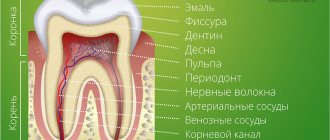Teething is one of the most important periods in a child’s life. This happens at about six months of age, but it is difficult to name the exact timing, since this process occurs individually for each baby. What do parents need to know about the names of their child’s teeth and the pattern of their appearance?
Name of a child's teeth
What are baby teeth?
Milk teeth are the teeth that are the first to erupt in humans. Their rudiments are formed in the womb, at approximately 5-7 weeks of pregnancy, and by the age of three the child already has 20 teeth. Milk teeth differ from permanent teeth in structure (they are smaller and have a different shape), and the bite does not contain small molars, or premolars.
X-ray of baby teeth
Number of teeth
Children have 20 primary teeth. Baby teeth first begin to emerge at 6 months. Children usually have all their teeth out by the age of 3. These teeth gradually fall out and 28 permanent teeth replace them. Sometimes the permanent teeth push the baby teeth out, but usually the permanent teeth pass through the gums at the back of the mouth behind the last baby tooth in the jaw. The first permanent teeth to emerge through the gums are the first four, or “6-year” incisors, so called because they usually appear when a child turns 6 years old. People typically lose all of their baby teeth by about age 14.
Scheme of baby teeth eruption
Normally, baby teeth begin to appear after the child reaches 5-6 months, but this period depends on a number of factors, including the quality and characteristics of the child’s diet, the region of residence and even the weather. Some children are born with one or more teeth; most often they must be removed because they interfere with normal sucking.
On a note! Milk teeth erupt symmetrically according to the so-called antagonizing principle, that is, teeth of the same name appear approximately simultaneously, and the process begins from the lower jaw. The exception is the lateral incisors, which begin to erupt from above.
Numbering of baby teeth
First, the two lower central incisors are shown, then the two upper ones, which are located directly above them. This order of teething ensures contact between the teeth and gives the baby the opportunity to begin to practice chewing solid foods. By the age of one year, a child, as a rule, has eight teeth. Next, two fangs grow - first on the lower jaw, then on the upper, after which the teeth of the chewing group (molars) erupt. At three years old, children can already fully bite and chew solid food.
Approximate order and pattern of appearance of baby teeth
| Name | Age, months |
| Central incisors on the lower jaw | 6-7 |
| Central incisors on the upper jaw | 8-9 |
| Lateral incisors, upper jaw | 9-11 |
| Lateral incisors, lower jaw | 11-13 |
| Upper molars (first) | 12-15 |
| Lower molars (first) | 12-15 |
| Fangs | 18-20 |
| Second molars | 20-30 |
Permanent teeth
A person normally has 32 permanent teeth:
- 8 incisors;
- 4 fangs;
- 8 small molars (premolars);
- 12 large molars - 6 upper and 6 lower teeth, 3 on each side of the dental arch. Third molars are called “wisdom teeth” [1].
But today, often people’s wisdom teeth Because of this, adults have 28 teeth. This suggests that a person evolves, unused parts of the body gradually disappear, are reduced or preserved, but do not carry a significant functional load.
Types of teeth differ both anatomically and functionally.
- Human incisors have one root; their crown tapers and forms a cutting edge. Their function is to bite off pieces of food.
- The canines are also usually single-rooted, the shape of the teeth is conical, their cutting edge is wedge-shaped. Functionally, they are designed to hold food in the mouth.
- Small molars (premolars) have 1-2 roots, the chewing surface of the crown has tubercles
- The lower molars usually have 2 roots, the upper molars have 3 roots, and there are cusps on the chewing surface of the teeth. These types of teeth mechanically process food: they grind, grind, which is why they are called chewing teeth.
A dense, thick layer of enamel, a special tooth structure - a smooth surface and pointed edges - protect the fangs from caries . Therefore, visits to dentists regarding dental pain are very rare.
How does the process work?
When the time comes for teething, the baby usually becomes restless, begins to put toys and other things in his mouth, bites his chest with his gums, and begins to salivate profusely. Parents may notice a small bump on the gum filled with fluid; the mucous membrane in this place becomes red and swollen. After some time, white spots clearly appear through the soft tissues - this means that the tooth is ready to be born.
Milk and permanent teeth
Important! If the lump becomes too large and causes serious discomfort to your baby, you can ask the doctor to cut it to “help” the tooth get out.
The body's reaction to teething depends on its individual characteristics. In some children this process is asymptomatic, in others the temperature rises, a runny nose, redness of the throat, diarrhea, sleep and appetite worsen.
Attention! If teething is difficult, accompanied by fever and other symptoms, it is better for parents to consult a doctor. Typically, in such cases, antipyretic and analgesic drugs are prescribed, as well as ointments and gels that reduce discomfort in the gums.
Types of teeth
You can relieve discomfort from teething by massaging your gums (performed with a clean finger) or by purchasing a special stimulator ring at the pharmacy.
- When do children's fangs change to permanent ones?
What to do if baby teeth are delayed?
The absence of signs of teething in a child at a time when other children already have several teeth is not a cause for concern. The exact timing depends on several factors, including:
- genetic characteristics;
- climate and living conditions;
- feeding habits (in children who are breastfed, teeth usually appear later than in “artificial” children);
- quality of child care;
- nutrition and living conditions of the mother during pregnancy;
- the presence of chronic diseases and pathologies.
Numbering of teeth in dentistry for children
A situation where teeth are completely missing in a one-year-old child should be a cause for concern - sometimes this is a variant of the norm, and sometimes it indicates disorders in the body.
Important! The most common pathologies that can affect the timing of teething are dysfunction of the endocrine system and rickets.
Less common is a disease called edentia, or the absence of tooth buds, which can be diagnosed using x-rays.
Caring for baby teeth
Children should be taught oral care procedures from early childhood. After the first teeth appear, it is recommended to gently wipe them once a day with a clean piece of gauze soaked in boiled water. As your baby gets older, you can purchase your own soft-bristled brush and brush your teeth with water. After the baby reaches one year of age, it is recommended to purchase a special paste and teach him how to care for the oral cavity on his own.
Teeth of the upper and lower jaw
Milk teeth, like permanent teeth, are susceptible to decay and caries, which can appear even in children under two years of age.
On a note! The main feature of childhood caries is multiplicity, that is, it often affects not one, but several teeth, penetrating into the deep layers of tissue.
At the spot stage, the disease is treated with fluoridation; in case of an extensive pathological process, cleaning of carious cavities and removal of infected tissues is necessary.
Formula for recording baby teeth using the Haderup system
Popular types of x-rays of baby teeth in children
Modern pediatric dentistry allows us to solve any problems with baby teeth. But in order to consider the disease and make a correct diagnosis, it is not enough just the child’s complaints and his description of pain and discomfort. In order for treatment to be as effective as possible, it is necessary to build a treatment plan based on diagnostic data that can be obtained after one of four popular types of radiography:
- Sighting (periapical). Indicated in cases where clarification is necessary on one or more adjacent teeth (from 1 to 3). Provides data about the units themselves, their roots and surrounding soft tissues.
- Occlusal (palatal). As a result, the attending physician receives a complete projection of one of the child’s jaws. The technique is used to determine possible malocclusions and anomalies of the dentition in general.
- Panoramic (orthopantomogram). Allows scanning of the entire oral cavity. An orthopantomogram for children is indicated for a detailed study of pathologies of the upper and lower jaw, the temporomandibular joint and the maxillary sinuses. The results of such an x-ray are necessary for further dental correction. This type of examination is prescribed for children with a fully formed dental system, that is, from about 9 years old.
- 3D pictures. A three-dimensional X-ray image of children's primary teeth allows us to obtain data on all units (existing and not yet erupted). The entire maxillofacial area is subject to examination. The photographs can be used to evaluate the structure of the entire skeletal system of the jaws, the condition of the root system (including pathologies), inflammation in soft tissues, etc. Such dental x-rays are prescribed for the purpose of making a diagnosis and as a control study after canal filling.
Depending on the existing problems with baby teeth, the child may be prescribed one specific or several different types of examination. The attending physician will definitely explain the advisability of obtaining images and the need for x-rays.
You might be interested in:
Dental diagnostics
Pediatric orthopantomogram
3D image of teeth
When do permanent teeth appear?
The replacement of baby teeth with permanent teeth occurs once in a lifetime, in early preschool age. Permanent teeth are divided into two groups: replacement teeth, that is, those that have “twins” in the primary dentition, and additional teeth (premolars and molars). The timing of the eruption of permanent teeth is also individual and depends on genetic factors, region and living conditions, and quality of nutrition.
Structure of a baby tooth
| Name | Age, years |
| Molars (sixths) upper and lower | 6-7 |
| Central incisors on the lower jaw | 6-7 |
| Central incisors on the upper jaw | 7-8 |
| Incisors on the side of the lower jaw | 7-8 |
| Incisors on the side of the upper jaw | 8-9 |
| Fangs on the lower jaw | 9-10 |
| Fangs on the upper jaw | 11-12 |
| Premolars (4s) | 10-12 |
| Second premolars (5ths) | 11-12 |
| Second molars (7s) | 11-13 |
| Third molars (wisdom teeth) | 17-25 |
Dental formula
For reference! The eruption of permanent teeth usually does not cause children any discomfort - after the roots are reabsorbed, the baby teeth fall out on their own, and permanent teeth appear in their place.
During this period, parents need to monitor the child’s proper oral hygiene, as well as ensure that the permanent teeth grow evenly, without gaps or distortions. If the bite has defects, it is necessary to consult an orthodontist as soon as possible to correct it. Find out about the alveoli in the mouth from the article.
- Molars in children: order of eruption
Video - Baby's first teeth
Anatomical structure of teeth
The anatomy of human teeth distinguishes the following parts of the tooth:
- A crown or anatomical crown is the thickened outer part of a tooth covered with enamel. They consist of the upper and lower dentition.
- The neck is the smallest anatomical part of the tooth, located between the crown and the root. Normally, the neck of the tooth is not visible, and its exposure may be a sign of disease.
- The root of the tooth is its supporting part, normally it is not visible, is covered by the gum and is located inside the alveolar socket of the jaw, ending with an apex - a rather sharp end, tightly fixed in the bone tissue with the help of the periodontal ligament.
Children and healthy young adults normally have “short” clinical crowns. Healthy patients have well-developed gums, strong teeth that sit securely in the socket.
With age, the gums sink lower and the clinical crown lengthens. The neck of the tooth becomes visible from under the gum, and dentists talk about a “long crown” and a “short clinical root.” Such teeth require careful and careful treatment: they become fragile and are not firmly fixed in the alveoli of the jaw.











